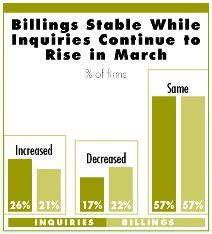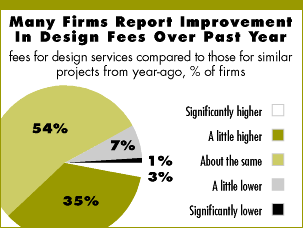
Firms report a generally favorable fees environment

by Kermit Baker, PhD
AIA Chief Economist
After four straight months of declining billings at U.S. architecture firms, the signposts say that business levels are beginning to stabilize. Billings in March were essentially flat compared to February levels, with 21% of firms reporting increases and 22% reporting declines. This was the second straight month in which the share of firms reporting growth in billings has jumped, so there is hope that the brief slowdown in this sector is over. Inquiries for new projects were up at a steady pace from February levels. The growth in inquiries, however, continues to be below year-ago growth rates.
 Business
conditions at firms are fairly comparable across all regions of the country.
However, firm specialization has a very strong relationship to business
conditions. Residential firms are reporting strong growth in billings,
with a third of firms indicating increased billings in March. Firms concentrating
in the commercial/industrial sector report weaker billings.
Business
conditions at firms are fairly comparable across all regions of the country.
However, firm specialization has a very strong relationship to business
conditions. Residential firms are reporting strong growth in billings,
with a third of firms indicating increased billings in March. Firms concentrating
in the commercial/industrial sector report weaker billings.
Construction sector
a bright light
The overall economy remains fairly weak, although the recent drop in interest
rates by the Federal Reserve Board seems to have given it a boost. Short-term
interest rates have been pushed down a cumulative two percentage points
since the beginning of the year, which has helped to solidify an economy
that was already showing some signs of improvement.
The construction sector remains one of the bright lights in an otherwise deteriorating business environment. Housing starts have remained surprisingly strong. The 1.61 million starts in March—when seasonally adjusted and annualized—brings the average to 1.64 million for the first quarter for the year. That pace is in excess of the 1.61 million starts for 2000, so the housing sector is one of the few growth engines in the economy. A strong housing market and favorable interest rates have generated a wave of refinancings this year, producing lower mortgage payments for many homeowners. Lower mortgage payments in turn have freed up funds for consumers for other purchases.
 Overall
employment growth has been fairly weak this year, with payrolls increasing
by less that 400,000 through the first quarter. However, 150,000 of these
net new jobs have been in the construction sector. This sector, therefore,
has been responsible for 38% of the job growth this year even though it
accounts for only about 5% of jobs in our economy.
Overall
employment growth has been fairly weak this year, with payrolls increasing
by less that 400,000 through the first quarter. However, 150,000 of these
net new jobs have been in the construction sector. This sector, therefore,
has been responsible for 38% of the job growth this year even though it
accounts for only about 5% of jobs in our economy.
Fees a little higher
With a reasonably strong construction sector, less pressure on fees for
design services would be expected. We asked our panel how fees at present
compare with those from similar projects from a year ago. Over half of
firms indicated that fees are about the same as a year ago on comparable
projects. However, over a third of firms indicate that fees are a little
higher this year, and 3% report that they are significantly higher.
Smaller firms, which often see less competition, were more likely to report higher fees this year. Over half of firms with annual billings of $250,000 or less reported higher billings, as compared to less than 30% of firms with billings of $5 million or more. Residential architecture firms, which tend to be smaller, were very upbeat about the fee environment. Fully two-thirds of residential architects report an improvement in fees this year.
Copyright 2001 The American Institute of Architects. All rights reserved.
![]()
|
Stand Up and Be Counted—Join the Work-on-the-Boards Survey Team Be one of the hundreds of firm principals who spend just a few minutes each month answering a fax-back survey (usually two questions). For more information on how to participate, send an email to Pradeep Dalal, call him at 202-626-7354, or send him a fax, 202-626-7508 |
|